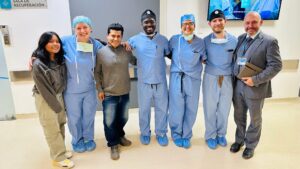This study examines the immune and inflammatory responses associated with coronary artery bypass grafting (CABG) performed via on-pump and off-pump surgical techniques, with a specific focus on the role of extracellular vesicles (EVs) as mediators of these processes. Thirty-six male patients, aged 18 to 75, were enrolled in the study and randomly assigned to undergo on-pump or off-pump CABG. Preoperative and 24-hour postoperative blood samples were collected to assess immune cell subsets, cytokine levels, and the phenotyping of plasma EVs using advanced flow cytometry and multiplex cytokine assays.
The findings revealed notable differences in the immune responses triggered by the two surgical methods. On-pump CABG, which utilizes a cardiopulmonary bypass machine, elicited a more pronounced inflammatory response compared to off-pump CABG. This was evidenced by a significant increase in the levels of EVs derived from platelets (CD62P+), endothelial cells (CD31+), and B-cells (CD19+). In contrast, off-pump CABG was associated with milder changes in both EV concentrations and cytokine profiles, aligning with its reputation for reducing systemic inflammation.
Platelet-derived EVs (CD41+) were among the most prevalent in plasma, both preoperatively and postoperatively. However, their levels exhibited a marked reduction after surgery, particularly in EVs expressing activation markers (CD41+CD62P+), which decreased in both patient groups. Interestingly, single-positive platelet EVs (CD41+CD62P−) showed an increase, indicating a shift in EV composition post-surgery. These findings underscore the role of EVs as active participants in the immune and coagulation processes during and after CABG.
T-regulatory cell-derived EVs (CD73+CD39+), known for their immunosuppressive properties, demonstrated a significant increase only after on-pump CABG. This suggests that on-pump procedures may induce a more complex regulatory immune response. The study also observed a higher concentration of erythrocyte-derived EVs (CD235a+) in the on-pump group, which correlates with the increased likelihood of red blood cell damage and transfusions in these patients.
Correlation analysis revealed extensive interrelationships between EV subsets and cytokine levels in patients undergoing on-pump CABG. Platelet-derived EVs (CD62P+) and erythrocyte-derived EVs (CD235a+) exhibited negative correlations with T- and B-cell levels, while leukocyte-derived EVs, such as those from T-cells and B-cells, demonstrated strong positive correlations with cytokine levels like GRO, IL-15, and sCD40L. These findings suggest that EVs act as dynamic regulators of the postoperative immune environment, particularly following on-pump surgery.
Endothelial-derived EVs (CD31+), which are critical markers of vascular injury and inflammation, were reduced after on-pump CABG but remained stable in the off-pump group. This aligns with previous studies showing that cardiopulmonary bypass is a stronger trigger for endothelial activation and damage compared to off-pump procedures. Moreover, the interplay between endothelial EVs and cytokines such as TNF-α and IL-1 further underscores the vascular stress associated with on-pump surgery.
The study also highlighted the role of leukocyte-derived EVs in modulating inflammation. For instance, B-cell-derived EVs (CD19+) increased significantly after on-pump CABG, reflecting their involvement in adaptive immune responses. These EVs were interconnected with cytokine levels and other leukocyte-derived EV subsets, demonstrating their central role in orchestrating immune regulation during postoperative recovery.
In conclusion, the study provides compelling evidence that on-pump CABG induces a more substantial immune response compared to off-pump procedures, with significant changes in EV concentrations and cytokine profiles. EVs emerge as key mediators in this process, influencing inflammation, coagulation, and immune cell interactions. The findings underscore the potential of EV profiling to improve postoperative management and reduce inflammation-related complications in cardiac surgery. Further research into EV-targeted therapies may offer new avenues for optimizing outcomes in CABG patients.







